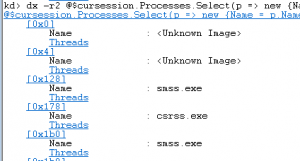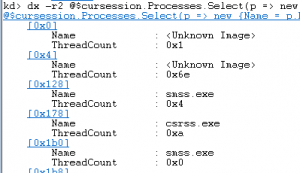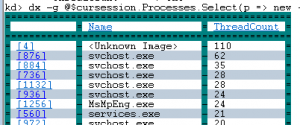Ask Learn
Preview
Please sign in to use this experience.
Sign inThis browser is no longer supported.
Upgrade to Microsoft Edge to take advantage of the latest features, security updates, and technical support.
Note
Access to this page requires authorization. You can try signing in or changing directories.
Access to this page requires authorization. You can try changing directories.
Hi Everyone!
For those of you that haven't seen, we recorded an episode of Defrag Tools with our friend Andrew Richards where we talked a bit about the debugger object model. You can find it here!
Today I'm going to do a tutorial covering the basics of how to write a LINQ query from start to finish for those of you that might not be familiar with LINQ and the thought processes behind creating a query. Let's start with the basics. What is LINQ and why should you care about it?
LINQ is a query language conceptually similar to SQL that can be used to query data, you can read a bit more about it here. C# developers are likely familiar with LINQ and how useful it is when looking at data. For those of you that aren't familiar or haven't looked at LINQ from the debugging perspective, it adds amazing value, it lets you take some structured data (in our case, the debugger object model) and query it to produce the exact output you want. It’s worth noting that our LINQ support uses the “method syntax” of LINQ and not the “query syntax” you can find more details about the differences on MSDN here.
In the past, if you were investigating an issue you've never seen before, your workflow would likely involve running a few debugger commands you're familiar with, and then searching for an extension or debugger command related to the issue you're looking at. Then you would learn the syntax of the command, run it, spend some time understanding the output, and hopefully the person who wrote the extension added the data that you want and outputs it in a friendly way.
For example, the query we're going to write today covers a few simple LINQ concepts and does a pretty basic task of getting the list of processes in a kernel debug session and the number of threads for each of those processes. I asked a few developers how they would accomplish this and got the four different answers:
None of those(except writing a new extension) actually give exactly what we'd want. Each of those spit out a list of threads, so we could take that list and count each individually or put it into Excel, but that's not very helpful. If I want to correlate the number of threads to another piece of data that might be relevant, like the number of modules, I'd have to go through the same process to figure out what extension contains module information. So let's see how we'd do this in LINQ!
A few generic tips:
Note that what I'm walking through is just one way of thinking about this, there's many different processes people have for writing queries. The query we're going to write today is to get a list of all the processes in a kernel debug session and the number of threads inside each of those processes.
The three basic steps to writing a query are:
We pretty much already said this above when we were defining the question:
This varies depending on what you're doing, I start by clicking around a 'dx Debugger' query. So a bit of digging gives me:
Now I know that all the processes are listed under the "Sessions" object, and all the threads are listed under the "Process" object.
Finally, the harder part, actually writing the query. I'm going to go through step-by-step and highlight the changes in each step. Note that the command outputs I'm putting here are truncated to show only a few rows of data. In this example I’m in a kernel debugger session, but the concepts work in both user-mode and kernel-mode.
I know I'm going to be looking at processes, so I need to "root" my query at the processes level, I have three options for that. Options 1 and 2 are pretty similar, they'll work for the current session I'm in, but if I share my query or have multiple targets at once, they won't work. The third option is a bit shorter and will always target my current session.
| Input:1. dx Debugger.Sessions[0].Processes2. dx Debugger.Sessions.First().Processes3. dx @$cursession.Processes | Output: |
Now that we've got the start, we need to select the process name and thread count from that namespace. This is where LINQ comes in, let's start with just getting the process name. The syntax inside the Select is LINQ's lambda syntax and is described on the 'dx' MSDN page here.
| Input:dx @$cursession.Processes.Select(p => p.Name) | Output: |
We don't just want the name though, we'll also need the number of threads, so let's grab the thread object also. Because we're grabbing two fields, we need to create an anonymous type, similar to C#'s anonymous type syntax.
| Input:dx @$cursession.Processes.Select(p => new {Name = p.Name, Threads = p.Threads} ) | Output: |
With that command, 'dx' doesn't actually print out the name anymore, just a link. Adding -r2 (recurse two levels) will fix that.
| Input:dx -r2 @$cursession.Processes.Select(p => new {Name = p.Name, Threads = p.Threads}) | Output: |
Now we have the name of the process and the list of threads, but that's not quite what we want, we want the number of threads.
| Input:dx - r2 @$cursession.Processes.Select(p => new {Name = p.Name, ThreadCount = p.Threads .Count() }) | Output: |
We're almost done! When writing this, I originally was looking at what processes had a large number of threads, so let's order the list by thread count.
| Input:dx - r2 @$cursession.Processes.Select(p => new {Name = p.Name, ThreadCount = p.Threads.Count()}) .OrderByDescending(p => p.ThreadCount) | Output: |
Since I'm going to share this, I want it to be as polished as possible. Most people have an easier time reading decimal, so I’m going to add the ',d' format specifier(see the 'dx' MSDN page for the full list of possible specifiers) to output decimal. Also, grids are a bit prettier than lists, so I'm changing the '-r2' to be '-g'. I no longer need the ‘-r2’ because ‘-g’ picks the right columns for me.
| Input:dx -g @$cursession.Processes.Select(p => new {Name = p.Name, ThreadCount = p.Threads.Count()}).OrderByDescending(p => p.ThreadCount) ,d | Output: |
There you have it, we just wrote a query to sort processes by the number of threads! If you want an exercise, earlier I mentioned that you could easily modify this query to also list the number of modules in the process, can you modify the query we just wrote to also include the number of modules? Note that this will give you the number of kernel modules, so every process will have the same number in this example.
Feel free to leave any questions, comments, or cool LINQ queries you come up with in the comments below.
-Andy
@aluhrs13
Please sign in to use this experience.
Sign in